Internal Problems and Outside Meddling.
Where Will It Lead?
Like other countries of post-Cold War Eastern and Southeastern
Europe, Ukraine is a country haunted by internal problems, polarization,
poverty of the many who had such great expectations, unscrupulous enrichment
of the few, a deep and unsolved economic crisis, and conflicting nationalisms.
It is also plagued by outside meddling. We are usually told it's the Russian
government that interfers in their internal affairs. Yes, they do. But
are they the only ones? And who acts, and who reacts? As so often, it helps
to look back, not just to the events on Maidan Square in early 2014, but
perhaps at least to 2004, if not a lot deeper into the country's history.
In December, 2004, Victor Yushchenko, the election candidate
favored in the Western parts of Ukraine, “said […] that attempts to make
Russian the country's second official language ha[s] become a political
issue.” (1) He was against Russian as
a second official language. The statement as such was indicative of the
rift between the West and the East of the country, and of the intolerance
among Western Ukrainian nationalists. It was an intolerance nourished by
resentment and traumas. Wrong as it was and still is, it is also understandable.
In order to understand it, one has to look for its roots.
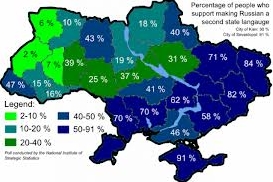
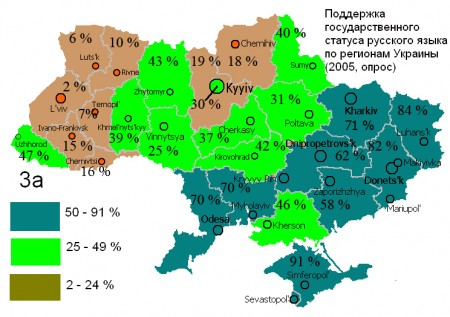
Percentage of people who support making Russian an official second
language (2005)
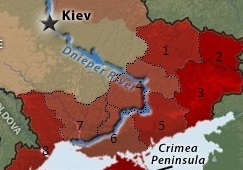
Native speakers of Russian
native Russian native speakers
speakers (%) of Ukrainian (%)
(1) Charkov
. 44.3
53.8
(2) Lugansk
68.8
30.0
(3) Donetsk
74.9
24.1
(4) Dnjepropetrovsk 32.0
67.0
(5) Zaporozhe
48.2
50.2
(6) Cherson
24.9
73.2
(7) Mikolaev
29.3
69.2
(8) Odessa
41.9
46.3
Source: http://www.liga.net/infografica/104824_novyy-vavilon-karta-regionalnykh-yazykov-ukrainy.htm
In the period following the attack of Nazi Germany on
the Soviet Union, then a U.S. ally, many Western Ukrainians had welcomed
the Nazi invaders, lining the streets of small towns and villages, flowers
in their hands, as Nazi wehrmacht tanks passed through. It was a view that
resembled the welcome of U.S. troops in small towns and villages of Normandy
after the invasion. Quite a few nationalist young Western Ukrainians joined
an auxiliary army corps in 1941 that fought side by side with the Nazi
wehrmacht army against the Soviet Union. Others became guards in Nazi concentration
camps, taking part in the genocidal murder of Poles, Jews, and White Russians.
Still others took part in anti-partisan actions and the rounding up of
Jews carried out by the infamous Nazi German sonderpolizei (i.e., special
police) units. The Ukrainian nationalists hoped of course that Hitler
Germany would favor the establishment of an independent Ukrainian puppet
regime, similar to the one that existed in Slovakia. When this was not
forthcoming, certain Ukrainian nationalists turned against the Germans
and the Russians. Their hero and leader was Bandera. He is still admired
and venerated by many Western Ukrainian nationalists.
In Eastern and South Eastern Ukraine, the situation was
different. Many Russians settled in these areas. The industrialization
effort in the Donbas region had brought a large influx of workers
from the entire Soviet Union, something that marginalized the kind of Ukrainian
nationalism that led to collaboration in the Western districts. And the
port cities at the Black Sea coast had always been more cosmopolitan than
nationalist in the 19th and 20th century. When the country was attacked
by Nazi Germany, these people, regardless of their approval or disapproval
of Stalin's pre-war policies, proved ready to resist the attack. The viciousness
of both the attack itself, the “special measures” taken in Nazi-occupied
territories, and the scorched earth tactics of retreating wehrmacht troops
all bolstered a heroic anti-fascist spirit among those who resisted Hitler
Germany. The memories of the sacrifices made are kept alive in oral
history, in the narratives transmitted among family members, and in cultural
life, generally. In the post-World War II period, heroic monuments commemorating
the sacrifices made by soldiers of the Red Army and the anti-Nazi partisans
were erected in many parts of the Soviet Union, and thus also in Ukrainian
towns. Today, Western Ukrainian nationalists have begun to tear them down,
causing suspicion and anger among other Ukrainian citizens, mainly in the
Eastern parts of the country.
If in the Eastern areas, identification with the victory
over Nazi Germany is still prevalent, in the West of the country, the opposite
is largely true. Defeats, not victory color the collective memory. Anti-Russian
resentment is strong. In 1945, the Nazi collaborators continued a partisan
struggle against the Soviet authorities that was supported by
the C.I.A. since at least 1947, and well into the 1950s, when the
guerilla was finally defeated. In these early post-war years of the late
1940s and early '50s, the Western Ukrainian guerilla murdered a considerable
number of directors of collective farms, of Communist party secretaries,
village and small town mayors and so on. In other words, the right-wing
nationalists – supported covertly by the U.S. government –
murdered those Western Ukrainians who threw their lot with the authorities,
either out of conviction or due to careerism, or because they were compelled
by the Soviet government to accept such posts.
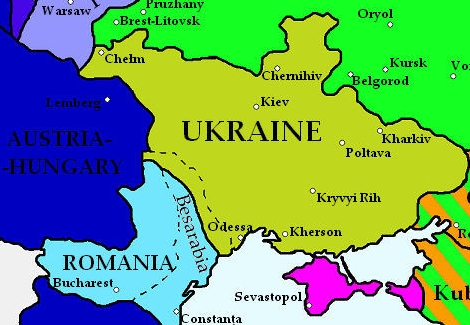
This map shows the situation after the peace treaty signed in
Brest-Litovsk. Russia is depicted in green, Austria-Hungary, the German
empire and their Bulgarian ally are shown in blue. Ukraine had been created
as a de facto ptotectorate of the Germans, governed by a "hetman" and controlled
by the German imperial army. French troops occupied Crimea.
It is clear that this historic experience had traumatic
effects. But many historians in search of the roots of Western Ukrainian
traumas (and the resulting extreme nationalism) also refer to the big famine
that cost so many lives in Ukraine in the early 1930s. Actually, there
were at least two, if not three terrible periods of famine. In 1917-1918,
the occupying German forces bought or confiscated large quantities of food
which was then exported in order to feed the starving German population;
this created a food shortage in Ukraine. The civil war between Czarist
troops in Southern Ukraine, Machnoist anarchist troops and Bolshevik troops
ravaged the country and made sowing and harvesting next to impossible in
1919-1921. It brought about severe regional starvation. And thus, in the
aftermath of the civil war, bands of orphaned, hungry children roamed the
country, in search of food. Workers in Western and Central Europe collected
money in solidarity, hoping to aid the starving.
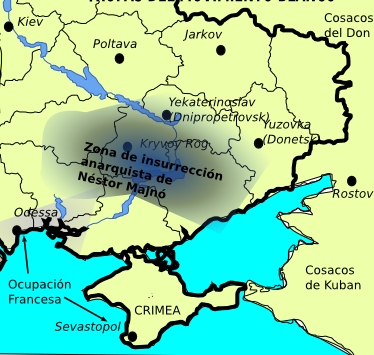
When the Germans withdrew, "White" troops commanded by Czarist
generals took control of Ukraine.
The area affected in 1919 by the anarchist insurrection, led
by Nestor Machno, is shaded darkly.
Odessa and Sevastopol were still occupied by French intervention
forces that supported the Czarist or "White" troops.
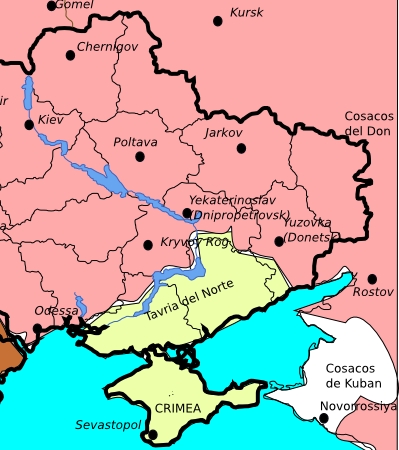
In March, 1920, the "White" troops controlled only a remnant
of Ukraine in the South, and the Machnoist units had also been defeated
by the Red Army.
During the so-called NEP period the situation improved
but the government in Moscow noticed also negative consequences. When Stalin's
government ordered collectivization of the agricultural sector to be carried
out in the early 1930s – a nonsensical policy, in many respect because
it disregarded traditions of mutual help and replaced the “peasant way”
of cooperating by a bureaucratic way that favored “industrialized” American
production methods –, a producers' strike resulted, mainly among middle
and rich farmers.
It may seem strange today that there existed rich and
middle farmers after the October Revolution, but the revolution had not
expropriated them and the farmer's markets allowed by the New Economic
Policy had improved their lot. In German-speaking areas along the Dnjepr,
for instance among German-speaking Mennonites in the Zaporozhe area, affluent
farmers were predominant. It was possible that a wealthy farmer, who had
profited from NEP policies, owned two modern tractors by 1928. In
the German-speaking villages, work was done mainly by family members, and
families were usually large. But the lowly work was delegated to Russian
or Ukrainian servants. Paternalist relations between master and day laborer
had even entailed inhuman practices under Czarist rule and during the civil
war. Agricultural workers were often beaten or flogged when talking back
or proving too undisciplined, in the opinion of their employers. During
the revolution and the civil war, a considerable number of the village
poor had turned to the anarchists, sometimes also to the Bolsheviks, and
in the towns, many industrial workers had turned to the Bolsheviks while
the educated (with the exception of quite a few Jewish intellectuals and
a few other progressives), the middle class, the merchants and so on tended
to oppose them. Thus, by 1930, the Soviet authorities did not find a united
front of opposition to their collectivization measures in Ukrainian villages.
Class antagonism and animosities that dated back to earlier periods continued
to exist and this meant that the authorities found those, locally, they
could lean on.
It was clear to people like Lenin, Trotsky, and Stalin
that the military victory of the Bolsheviks in the civil war and the fact
that they rose to power, politically, did not quell anti-revolutionary
sentiment among those who had opposed them. Under Stalin, and perhaps even
before he took absolute control, the political apparatus created to repress
such dissidents developed its own dynamics, however, similar in some respects
to the way in which internal security concerns are leading today to a continually
expanding security state. In the 1930s, the resistance to collectivization,
put up mainly by rich and middle farmers in Ukraine – which was the bread
basket of Russia and which had been an exporter of food under the Czars
(when lucrative exports had periodically produced high bread prices and
widespread malnutrition among the poor) – could only be passive resistance.
The farmers who were forced into a collective farm (a so-called kolkhoz)
frequently worked carelessly; in many cases, they planted and harvested
just enough to feed themselves. Surplus grain was left to rot in the rain
rather than sheltered from the weather in barns. When the amount of harvested
grain proved abnormally small, those who had “sabotaged” things in the
opinion of the government were arrested, taken away, and presumably shot.
Those who remained behind in the village where compelled to give all the
food resources kept for themselves, in order to fill the normal quotas.
The regime had no other way. The workers in the cities – their main power
base – had to be fed. The cities depended on food from Ukraine. With a
disastrous harvest in Ukraine, their rations had to be cut, too. The villages
that had refused to produce a normal output because they resented a form
of cooperation ordered bureaucratically from above, paid a terrible price.
Many died of starvation. But urbanites were exposed to malnutrition, as
well. This famine is still part of the historic legacy that separates Ukrainians
with rural roots from “the authorities” in Moscow – and from Russian-speaking
miners and steelworkers (or today, ex-miners and former steelworkers) in
the Eastern Ukrainian Donbas region. It was the miners and steelworkers
of the Donbas who had received better rations during the famine, because
of their strategic importance for the country.
In 2004, the International Herald Tribune was preferring
a mild understatement when its journalist wrote that political resistance,
by nationalist West Ukrainian politicians, especially by Viktor Yushchenko,
to the introduction of Russian as a second official language was “likely
to anger voters in Russian-speaking Eastern parts of the country, most
of whom support his opponent” – presidential candidate Viktor Yanukovich.(2)
Russian had of course functioned as an official language
in Ukraine during the Soviet period. When Yeltsin agreed that a referendum
on the question of independence should be held, it was the Eastern part
of Ukraine that had featured a considerable number of voters who were in
favor of remaining a part of Russia. But those who say that their mother
tongue is Russian form only about one fifth of the population (while
Ukrainian citizens with Russian roots, according to other estimates that
are based on a number of socio-culturally relevant factors, account for
perhaps 30 per cent), and thus the forces of opposition to Ukrainian independence
were of course defeated.
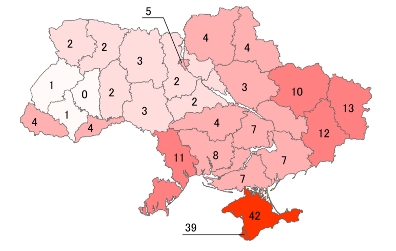
The referendum on separation from the former
Soviet Union, held in 1991. The dark red area featured an especially large
percentage of voters who opposed separation.
Nationalist sentiment in those days that saw Ukraine gain
independence ran high, and the new constitution that was adopted immediately
after Ukraine split with Russia stipulated that “Ukrainian” should be “constitutionally
protected as the language of government, the police and the military, universities,
and most schools.”(3) While “[m]ost children
are bilingual,” this will not necessarily stay so if Russian continues
to be suppressed as a means of communication that can be used in official
business, such as talking to a policeman or filing a tax report. Many native
speakers of Russians “fear […] promotion of Ukrainian at the expense of
Russian” because it may be “leading to discrimination in employment and
other area.” (4)
All of this must be seen in the context of the global
economic crisis and the grave economic difficulties that Ukraine seems
unable to cope with while its political pseudo-elite and its rapacious
post-Socialist tycoons continue to enrich themselves, in ways very
much like those noted in Bulgaria, Romania, Russia, and even to some extent
in Poland and Slovakia.
Socio-cultural conflicts rooted in different historic
experiences that give rise to different views of history and thus, different
“identities” and loyalties, are a distinct feature of Ukrainian reality.
In the West, the Roman Catholic church was strongly present in former Galicia,
a province – until 1918 – of Austria-Hungary. Today,
most Ukrainians say that they are atheists or that they do not belong to
a church. Only 1.7 per cent of the population of Ukraine belong to the
Roman Catholic church. Then, of course, there is also the Greek Catholic
Church – it, too, is loyal to the pope in Rome. 14.7 percent
of the population profess adherence to this section of Catholicism. If
both figures add up to only 16.4 per cent who are Catholics, we must not
forget that the socio-cultural imprint the church left in many Ukrainians
for generations, lingers on in the minds of more recent generations who
do not profess a formal adherence.
In view of the historic role of Constantinopolis and Kiev,
the Orthodox variety of Christianity is of course more strongly present
in much of the country. 38 per cent of the population belong to the section
of the Ukrainian Orthodox Church that is headed by the patriarch in Kiev,
and 29.4 per cent are indirectly members of the Russian Orthodox Church,
as they follow the patriarch in Moscow, even though they formally constitute
a section of the Ukrainian Orthodox Church.
The regional distribution of believers is obvious. Catholics
are overwhelmingly present in the Western part of the country that belonged
to Poland, then to the Austrian empire and then again to Poland. The believers
who look to Moscow are heavily present in areas with a considerable presence
of native speakers of Russian.
A socio-cultural East-West contrast exists in another
sense, as well. The West, despite some urban centers, is more rural. The
East was and to some extent still is a mining and steel-making region.
The Ruthenes, West Ukrainian mountain people of the Carpathian
region, were inhabitants of a particularly poor part of the country – and
famous for becoming soldiers in the Austrian army. Like so many poor people
from the backcountry, whether in the U.S. or the UK, they saw their
chance of advancement or of earning at least a living for the family
back home, in military service. Lack of education and the influence
of the Catholic church made them conservative; in 1848, Ruthenian army
units bloodily suppressed the democratic revolution of the Poles. In 1918,
the West Ukrainians in former Galicia coveted a republic of their own:
it was an understandable nationalist endeavour of small people who were
ready to emancipate themselves from the Austrian yoke. Their short-lived
National Republic of Western Ukraine was on difficult terms with the People's
Republic of Ukraine to the East of it that was governed briefly by anti-Bolshevist
Ukrainian social democrats. (This people's republic had no links to Bolsheviks
in Russia or Marxist revolutionaries in the Hungarian Soviet Republic.)
The National Republic of Ukraine was attacked by the young Polish Republic,
however, and defeated in bloody battle. These West Ukrainians, just escaped
from Austrian rule, were now ruled by Poland.
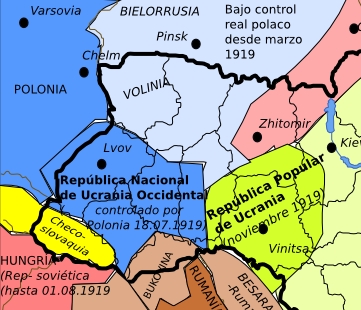
In a part of former Galicia, a National Republic of Western Ukraine
had been formed in the wake of the collapse of Czarist Russia. The territory
of this short-lived republic was annected by Poland on July 18, 1919. A
People's Republic of Ukraine existed in Western Ukraine just East of this
National Republic, It was subjected by the Red Army. The Hungarian Soviet
Republic formed at the end of WWI existed until August 1, 1919.
As Polish soldiers, they were forced to join the attack
of Britain, Japan, and Poland on the young Soviet Russian republic. When
the Soviet Red Army counterattacked, they too suffered losses. When the
Poles won in the end and peace between Poland and Soviet Russia was concluded,
they became part of a vast Poland, a country full of historic pride after
having recovered Ukrainian and White Russian lands once ruled by Lithuanian
grand-dukes and Polish kings. It was an authoritarian and repressive republic,
dominated by general Pilsudski until 1936. The West Ukrainians in
what was now Polish Galicia remained Polish citizens until the moment they
were occupied by the Red Army, as a direct result of the non-aggression
treaty concluded by Ribbentrop and Molotov – an agreement reached between
Nazi Germany and the Soviet Union that gave the latter country a brief
respite, until 1941, while sacrificing Poland. When Poland was divided
up, Western Ukrainians at home in Galicia joined the rest of Ukraine again,
under Soviet rule.
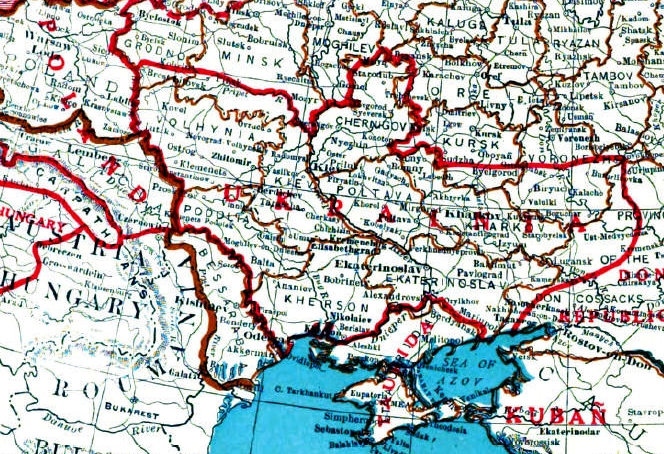
Ukraine in 1920
Galicia, as it were, had its own traditions. The Austro-Hungarian
monarchy prided itself of being more advanced industrially and in other
respects than Czarist Russia. There existed a more civil form of what we
would call today the rule of law than was the case under the Russian
czars. The civil service and the education system were fairly advanced.
If Czarist- controlled Ukraine experienced pogroms intermittently, in Austria-Hungaria
law and order was maintained and anti-semitism took on more subtle forms
between 1850 and 1918.
Of course, Jewish American writers with roots in Galicia,
like Isaac Bashevis Singer, have kindled our awareness of the “stedl” –
the Jewish parts of town that were a characteristic feature of many cities
in Austrian-ruled Galicia. The cities in Galicia were – if it is allowed
to use a modern term – in some way or sense multi-national cities.
There were Slovaks, Poles, Jews, Germans, Romanians, who had to get along
and who got along peacefully in Ukrainian cities of Austrian-ruled Galicia.
In the parts of Ukraine ruled by Czarist Russia, a similar mixture of populations
could be observed; in that respect, they were not very different. In the
sea ports, one could even find a considerable number of Greeks. The merchant
class, or commercial bourgeoisie, tended to be in a way cosmopolitian in
their outlook, contacts, commerical relations, and even, perhaps, in their
manners. And this despite definite national cultural trends and the stubborn
use of their maternal language, side by side with the official language
and other languages that proved useful to those accustomed to do business.
In comparison, the Ukrainian villagers and the servants of Ukrainian stock
seemed almost deficient. Like any exploited, subjected class, they were
robbed of the chance to unfold their human potentialities. It was this
deprivation that produced a chip on their shoulder while the grip, that
the Catholic church (in its Roman or Greek form) had on these “simple”
minds, contributed to their deep-rooted anti-Judaism, very much in the
same way as in Poland and in rural and small-town-Germany.
Ukrainian writers like Jura Soyfer, who was born in Charkov
[Kharkov; in Ukrainian: Kharkiv] in 1912, had Hungarian, Jewish, Polish
and German friends.(5) This was also
typical of Jewish intellectuals in other Ukrainian cities, especially in
important cities like Lvov (known as Lemberg, under Austrian rule). Soyfer's
father was a Jewish industrialist in Charkov. This was also not untypical.
In cities like Lvov [Lviv, or Lemberg], Charkov – or Lodz (a textile-industrial
city in Poland) – , Jews were either part of the industrial bourgeoisie,
bankers, merchants, or they were clerks, accountants, engineers, etc.,
while in the villages, they tended to be roaming peddlers, local hawkers
or shop owners, money lenders, horse dealers, and so on. Practically none
were likely to be farmers, peasants, blacksmiths... The poor among them,
and there were many, would have daughters who worked as maids, as household
helps, usually in the mansions of the Jewish bourgeoisie, and sometimes
in textile factories owned by Jews, while boys of poor families might get
a badly paid job in a small shop or office. Though the class structure
was reflected in the Jewish ambiente of Eastern European towns, the concrete
form of this existence was different from that of many Ukrainians. This
separate existence – upheld by anti-judaist religious sentiments,
by the historic existence of segregated quarters (“ghettos”), by
legally prescribed and also informal discrimination – perpetuated
stereotypes of the Jew as the Other, including such cliché-ridden
ideas as “the Jewish usurer” and “the clever Jewish businessman”:
widespread, popular views held by members of all classes who disregarded
both the proletarian reality of many poor Jews (a majority) and the
reality of emerging financial capitalist structures (which were by no means
“Jewish” in character, as Jewish bankers played a role that was not different
from the role played in this sector by Germans, Greeks, Frenchmen, Russians
and so on). The concept of usury was appropriate to a medieval reality,
and it vibrated with Catholic misgivings and preconceptions that condemned
interest-taking while supporting the inequality of a class society. But
as a simple category, linked to a “holy” text that forbade interest-taking,
it offered an easily comprehended simplistic view of the ills of society,
and it also provided a scapegoat – something that was of course only possible
because feudal lords and princes had indeed used some Jews as “strawmen”
who would use princely money to make loans at usurous rates, taking interests
on behalf of Christian rulers and taking a cut. These preconceptions of
the exploitative, speculating Jew linger still, in the minds of many simple
Ukrainians, butressed by the few among the Jewish community who (like
so many others) engage in property speculation, commodity speculation,
currency speculation, and so on. And as always, seducible – indeed,
gullible – simple minds are easily exploited politically, for concrete
reasons and with concrete purposes in mind. The Nazis were neither the
first nor the last to do this.
When Jura Soyfer was still very young, perhaps 7, perhaps
older, his family fled to Austria because his father was quite naturally
opposed to the new Bolshevik government that ruled Ukraine after having
defeated others vying for power in that part of Europe. In Vienna,
Soyfer was soon active in the Association of Socialist High School
Students when he was only 17.(6) The anti-Jewish
sentiments of average Ukrainians, and memories of pogroms that remained
alive in his family, were probably a factor that explains why a man like
Soyfer turned towards the Left inspite of his bourgeois class background.
This, too, was not untypical of Jewish intellectuals in Ukraine, Poland,
or Russia. Socialism promised the emancipation and equality of all members
of the human race.
In the wake of the collapse of the Soviet Union, the tendency
to embrace socialist ideals – observed between 1890 and 1947 among Jewish
intellectuals (and also among Jewish factory workers) – made
Jews in many parts of Europe, including Ukraine, again a scapegoat. Now,
in the minds of right-wing nationalist demagogues, it was seemingly clear
that it was only due to them that the October Revolution had occurred
and proved victorious, and then, again due to them, everything went wrong
later on – especially the crimes committed under Stalinism were blamed
on them. Thus everything that is seen as "bad" (or "evil") was and still
is easily attributed to Jews by the nationalist simple minds. The examples
of Trotsky and Rosa Luxemburg seemed to prove the point, but also the examples
of a writer like Jura Soyfer, a pioneer of modern theater like Meyerhold,
and so on. The fact that Stalin, a native of a Christian country, Georgia,
was educated in an Orthodox monastery, does not matter. Nor does it matter
that many willing helpers working in Stalin's GPU (or NKWD) had a Russian
orthodox, or Ukrainian Catholic background, whereas Jews were (proportionally)
just as present as other groups among Stalin's victims.
Today, the Jewish population in Ukraine is only a fraction
of what it used to be before the Nazi German attack. Jews were rounded
up in those years of Nazi occupation, often with the help of Catholic Ukrainians
– or they joined the partisans, hoping to at least resist, and perhaps
survive. Today, in Ukraine, it is a fact that a person risks being slighted
and despised by the nationalists if he (or she) reveals that the father,
mother, or uncle joined the struggle of the partisans. Those who did join,
have died already. Their offspring are forced to keep silent about it among
nationalist Ukrainians. As right-wingers ascend to power in the new government,
and also in view of the general climate in many parts of the country, a
number of Jewish businessmen are often eager today to profess support for
the new regime, or so it seems at least. In all likelihood, most of them
simply want to avoid the impression of being disloyal Ukrainians. The fear
of pogroms may distantly echo in their minds. And why should they
side with Putin and with Russian nationalists? Anti-jewish sentiments
and right-wing nationalism abound in Russia, too. The stedl is a
reality of the past; the cosmopolitanism of cities like Odessa has faded
away, and those who do not fit into the neat categories preferred by Ukrainian
nationalists and native-speakers of Russian are a marginalized, obscured
minority that ducks and seeks cover, in an atmosphere of heated nationalisms.
When in 2004, Yanukovuch's victory in the run-off election
on November 21 was contested, one could see already that Western politicians
and media took sides. It seems clear that indeed there were some irregularities.
But really more profound ones than in other countries (the U.S. included)?
If there was voter intimidation, if people cast votes in the names
of those too old or sick to vote, those in homes for the ages or patients
in hospitals, this is likely to have occurred in Western Ukraine (where
it hurt Yanukovich) and in Eastern Ukraine (where it hurt Yushchenko).
As in the race that put Gore against Bush, the outcome was predictably
close – which rules out major cheating. With the country so polarized,
it was a question of taking away a few percentage points from the adversary,
by honest or dishonest tactics. On November 26, 2004, USA Today
wrote that Yushchenko's claim to have lost the election due to election
rigging immediately “won significant international backing” by the
West.(7) According to
this paper, “Western observers
[…] cited voter intimidation” – and this even though there was no
secret police to interfere; it could only be peer pressure in precincts
heavily in favor of one candidate. They also claimed there was “multiple
voting” (which is very difficult to become aware of, empirically, as an
observer), as well as a good amount of other (unsubstantiated and unspecific)
“irregularities.”(8) It sounds very much like
the typical charges brought to bear in contested elections in the U.S.,
but “[t]he United States and the European Union said they could not accept
the results as legitimate” even before the courts had investigated the
claims of the Yushchenko camp.(9) It was clear
that the American and European political "elites" were disappointed because
the man they bet on (and financed, in part?), had lost this election. Therefore,
they “warned the Ukrainian government of 'consequences' in relations with
the West.”(10) Pressing for a repeat
election, Secretary of State Henry Kissinger, former National Security
Advisor Zbigniew Brzezinski and Senator John McCain all visited Kiev, in
official or private capacities, in order to support Yushchenko.
On the other hand, the fact that the Supreme Court of
Ukraine in Kiev halted publication and official recognition of the election
results until charges brought by the losing Yushchenko camp had been
considered and until an investigation had been concluded, seems to speak
for a normal process not unlike that preferred in the U.S. where the Supreme
Court had the final say on the contested ballots in Florida. Russia's
president, Mr. Putin, seemed more calm and reasonable than many Western
politicians; he said, according to USA Today, that “all claims relating
to Ukraine's election should be settled by the courts.”(11)
The contested 2004 elections thus revealed already both
the conflicting interests of the West and of Putin, a readiness to meddle
in Ukraine's internal affairs, and the rash way in which the West arrived
at a conclusion regarding the “rigged election.” It seems that in
the West, only Dutch Prime Minister Jan Peter Balkenende took a view that
was comparable to Putin's, in stating that “setting up a legitimate government
is essential. Any objections to the electoral process must be looked into.”(12)
USA Today noted, however, that the broad and sweeping
charges brought by the Yushchenko camp made it difficult to substantiate
them. According to Ukrainian election law, the Yushenko camp should have
legally challenged “election results from individual voting districts”
– district by district, substantiating its claims concretely in each case,
rather than making a general statement that the election which gave Yushchenko
46.61 % of the vote (against Yanukovich's 49.46%) was unfair.(13)
It speaks in favor of the judicial process (and for the
rule of law) that the court nonetheless voided the election and ordered
that a new election should take place. And thus, in Kiev, for several days
in December, 2004, “tens of thousands of Yushchenko supporters rallied
on the main square of the capital in a […] show of force” – voicing their
expectation that the “repeat presidential election” should be “free
and fair.” (14)
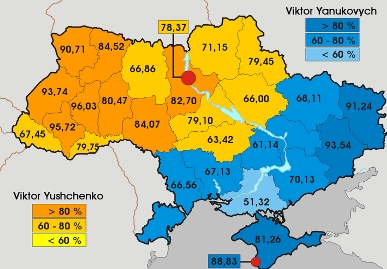
The presidential election in Dec. 2004
The expectation that the West connected with a possible
victory of Yuchchenko was clearly formulated in December 2004 by the Parisian
newspaper Le Canard enchaîné: “Si l'opposition [i.e.
Yushchenko] triomphe, il faudra alors causer de l'adhesion
de Kiev à Europe. C'est la prochaine étape, inéluctable...”
[If the opposition (i.e. Yushchenko) triumphs, it will cause
the adherence of Kiev (i.e. the Ukraine) to Europe (i.e., to
the West, thus either the E.U. or NATO, or both). This is unescapably
the next stage (of the political development aimed at by the
West and by politicians like Yushchenko, who are backed by a considerable
part of the Ukrainian population). ] (15)
It is a sign of the political independence of Ukraine's
legal system that the Supreme Court indeed ordered a repeat election. It
took place on December 26, 2004 and resulted in Yushchenko's victory. Western
media claim that Yanukovich lost because his adherents could not cheat
again. This is possible. It is also possible that the strong bias of the
media against Yanukovich and the heavy presence of Western politicians,
but also the large amount of money spent during the campaign, changed
the mood of some voters who had supported Yanukovich in November. Did this
meddling prefigure key developments in Ukraine during 2013 and 2014?
In the presidential election that took place in 2010,
Yanukovich came in first, perhaps because Ms. Timoshenko was discredited
due to what seemed to be heavy involvement in corruption. Ordinary Ukrainians
are indeed sick of corruption. In the next few years, the media had a new
message for them. Yanukovich was corrupt, too, and surrounded himself with
people who were corrupt. It was probably true.
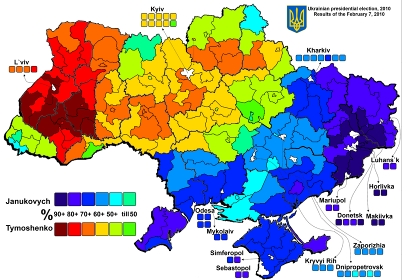
The presidential election in 2010
During the years when Yanukovich was in power, the question
of adhesion to the European Union became prominent. Again, the West took
an active interest in internal politics of Ukraine, and this can also be
described as "interference" or meddling. Again, the nationalist West Ukrainians
were ready to produce a show of force in the streets, above all, in Maidan
Square (Independence Square), a symbolic spot in the capital, Kiev. Again,
the political camp that is less enthusiastic to join the E.U. and NATO,
the camp that embraces neutrality as a constitutionally enshrined principle
of the country, and that leans heavily on native speakers of Russian in
Eastern counties and progressives in the West and center, proved defensive:
When provocative violence (that should have been investigated independently
by now) caused many victims on Maidan Square, members of parliament leaning
toward Yanukovich were attacked, others were pressured, some votes may
have been bought, but nonetheless the quorum of 75 percent necessary to
unseat Yanukovich as elected president of the country was not attained.
In a heated atmosphere of violence, exasperation, international condemnation
by Western governments (but not, for instance, by India), the legitimate
president fled, and we could immediately witness an unconstitutional formation
of a new government under a new interim president. It may remind some readers
of another instance of regime change, when the democratically elected president
of Brazil, Joao Goulart, fled first to Porto Alegre and then to Montevideo.
It is interesting that a German – slightly left-leaning
– liberal social scientists, Claus Leggewie, declared in January, 2005,
that there exists today, in his opinion, “no path that leads back to the
Cold War.”(16) It was an ominous attempt
to be prognostic, for it revealed exactly the opposite of the manifest
content of his statement. Everyone with a minimum of clear perception of
the developments in Europe and the world, and with some analytic capacity,
had to be gripped by a premonition or fear that another Cold War was already
knocking on the door. Of course, it is no longer a Cold War between self-proclaimed
“real socialism” (or etatist “communism”?) and modern oligopolistic capitalism,
but plainly between major capitalist powers. Leggewie described the
factual “prohibition to intervene in the inner affairs of states
governed in authoritarian fashion” as a constitutive element of the past
Cold War situation. Quite obviously he does not imply that
the U.S. would not intervene in Greece, in South Korea, in Iran, in
Indonesia, in Lebanon, in the Dominican Republic, in the Congo when Lumumba
was toppled and murdered, in Brazil when Joao Goulart was ousted, in Greece
again, and of course Turkey and Cyprus, in Italy (during the straghe
period), in Vietnam and Cambodia, in Guatemala (twice), in Chile, Argentina,
Bolivia, Uruguay, in El Salvador and Nicaragua, in Cuba, in Angola, in
Mozambique, in Haiti, in Columbia, in Venezuela, in Iraq, Yemen,
Somalia, Libya, Syria, Egypt. And perhaps I leave out a few examples. In
fact, they did intervene, in direct or indirect fashion, sending
the marines, sending experts, advisers, special forces, sending an entire
army, supported by the navy and the air force – there were always
so many ways and shades and intensities of meddling violently in another
nation's (and people's) public affairs. To enumerate merely such places
of intervention can gives us an idea of the scope of American neo-imperialism.
But it does not mean that the Soviet Union – or China, for that matter
– did not meddle in the affairs of other countries after 1945 or '49; the
Chinese most notably in the conflict between Vietnam and Cambodia, and
by supporting movements in Angola and Mozambique that were financed by
the U.S. and the apartheid regime, as almost everybody knew. And yet, Leggewie
is right in one respect: there existed mutually acknowledged spheres of
interest. The U.S. would not have dared to intervene militarily in Egyp
under Nasser for instance, and Soviet threats reigned in Anglo-French aggression
during the Suez crisis. Egypt was acknowledged as an ally of the Soviet
Union that the government of that country would try to protect. The big
superpowers were not keen to engage in direct military confrontation. Certainly
not over Egypt. The U.S. signaled Britain and France (two subimperialist
powers still invigorated, at times, by colonialist arrogance) that they
better stop it. Washington would not accept being pulled by them
into a military confrontation with the Warsaw Pact.
These things are a matter that belongs to the past. The
sole superpower that is left after the collapse of the Warsaw Pact, and
after an already weakened and discouraged Soviet Union was dismantled,
is today a power filled with the belief that nothing can stop or limit
it. It is ready, it seems, to take new risks – bigger ones than it was
willing to take in the Cold War. Leggewie interprets this lack of risk-aversion
in terms of America's democratic mission and missionary spirit, and he
suggests that Europe (i.e., the E.U.) should be ready to compete
with the U.S. in a joint effort to “spread democracy, freedom, and participation”
in the world. This is exactly what got us into the “humanitarian war” on
Yugoslavia and what destabilized Afghanistan and Iraq and Libya and Syria,
perhaps for a very long time, at tremendous human cost – and all in the
name of spreading democracy. It is what is adding fuel to the fire of war
that burns in Eastern Ukraine, and it conjures up the spectre of a much
wider and more horrible war. Leggewie, however, regretted that “humanitarian
interventions are still regarded with suspicion.”(17)
It is time to ask what it would mean if the West intervened militarily
in open fashion in present day Ukraine, claiming that the increasing
number of victims of a civil war that would never have erupted in the first
place without Western meddling, prompts it to embark on another “humanitarian
intervention.” It is also time to ask what other measures that the West
has taken or is prepared to take might bring us closer to war. We have
seen an escalation on the verbal level. We have seen efforts to wage an
"economic war." We see NATO bases edging closer to Russia. And we see NATO
planes and soldiers very close, indeed, to Russia's borders. Perhaps we
should not take the warnings of high-ranking officials in Russia lightly
that they will take only that much, and will act if their country's security
is imperiled in ways that go too far.
- Martha Wols
NOTES
(1) N.N., “In Ukraine, language is an election
issue,” in: International Herald Tribune, Dec. 23, 2004, p.3.
(2) N.N., “In Ukraine, language is an issue,”
ibid.
(3) Ibid.
(4) Ibid.
(5) Regarding Jura Soyfer, see: Erich Hackl, "Die
Farbe der Welt [The Color of the World], in: Junge Welt (Berlin),
Dec. 8-9, 2012, pp.10f.
(6) It was then that Soyfer published ´his
first poem in Schulkampf, a journal of this association. When
Soyfer was in his early twenties, he was already publishing satirical poems
in the German-language newspaper Arbeiter-Zeitung, the party newspaper
of the Social Democratic Workers Party of Austria (SDAP), a party
that proved its independence by developing so-called Austro-Marxist
theoretical positions. Perhaps it was not only the fact that he was now
living in Vienna which compelled Soyfer to write in German, rather than
in Ukrainian or Russian of Jiddish, but also that other fact that Jiddish
is so close to the contemporary German language. His choice thus resembles
Kafka's – for Kafka could also have opted to write in another language,
in Czech or in Jiddish, but he chose German. As Erich Hackl reports, Soyfer's
Hungarian friend Marika Szésci admired his integrity, his humor,
and his talent as a poet. Hackl mentions Soyfer's friendship with Erich
Fischer and notes that Soyfer was later imprisoned in Austria by the fascists.
Released in February 1938, he was again arrested while attempting to cross
the Austro-Swiss border. He was sent to Dachau, then to Buchenwald where
he contracted typhoid fever. On February 1939, in the darkness of night,
Soyfer died in Buchenwald, already a concentration camp, as the death camps
were called in those years.) See: Erich Hackl, ibid.
(7) Anna Melnichuk, “Ukrainian court halts publication
of elections results,” in: USA Today, Nov. 26, 2004, p.4.
(8) Anna Melnichuk, ibid.
(9) Anna Melnichuk, ibid.
(10) Anna Melnichuk, ibid.
(11) Anna Melnichuk, ibid.
(12) Anna Melnichuk, ibid.
(13) Anna Melnichuk, ibid.
(14) N.N., “In Ukraine, language is an election
issue,” International Herald Tribune, Dec. 23, 2004, p. 3.
(15) N.N., “Ukraine et chouchous de Bruxelles,”
in: Le Canard enchaîné, Dec. 8, 2004, p.1.
(16) Thilo Knott, interview with Claus Leggewie,
“Kein Zurück zum Kalten Krieg” [No return to the Cold War), in: taz
[die tageszeitung], January 22/23, 2005, p.3.
(17) Thilo Knott, interview with Claus Leggewie,
ibid.
|